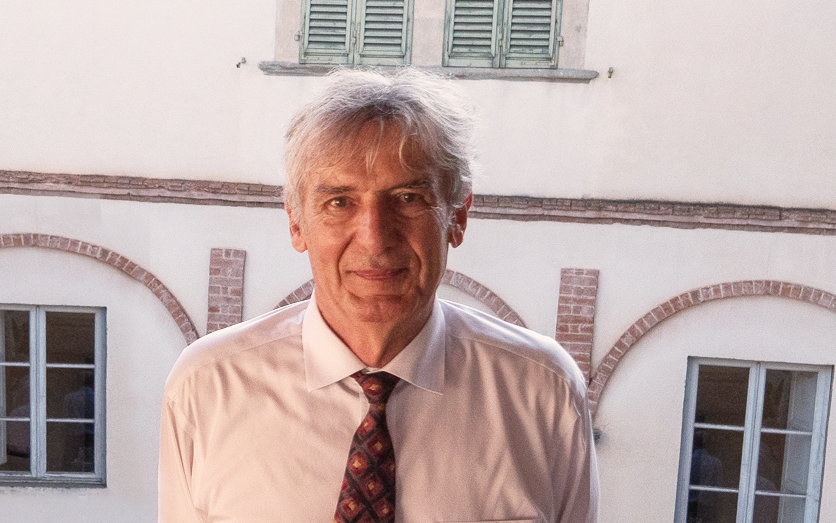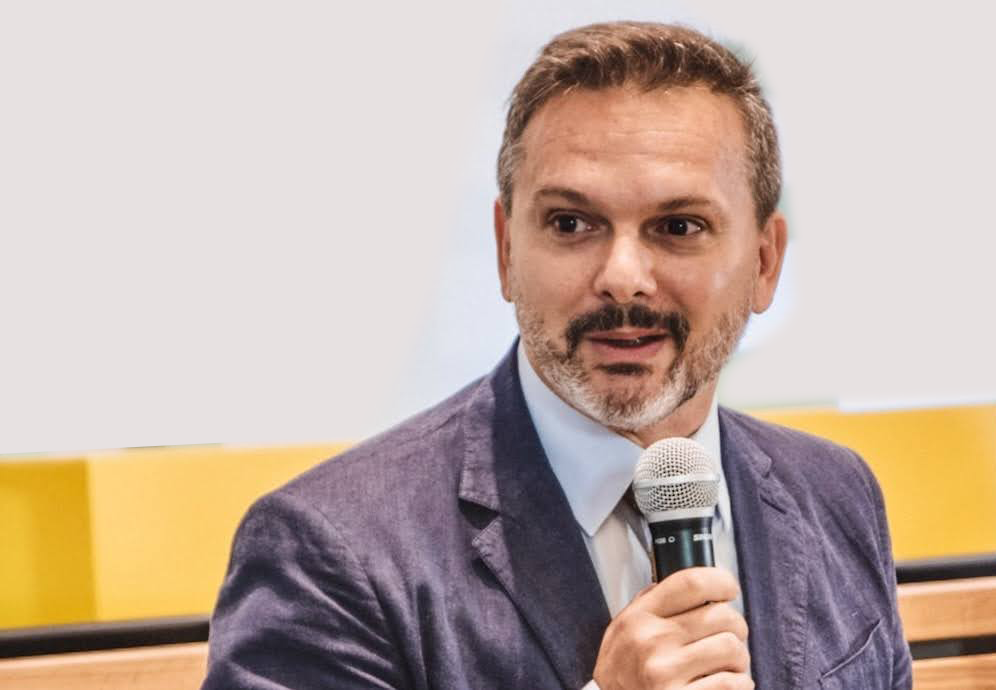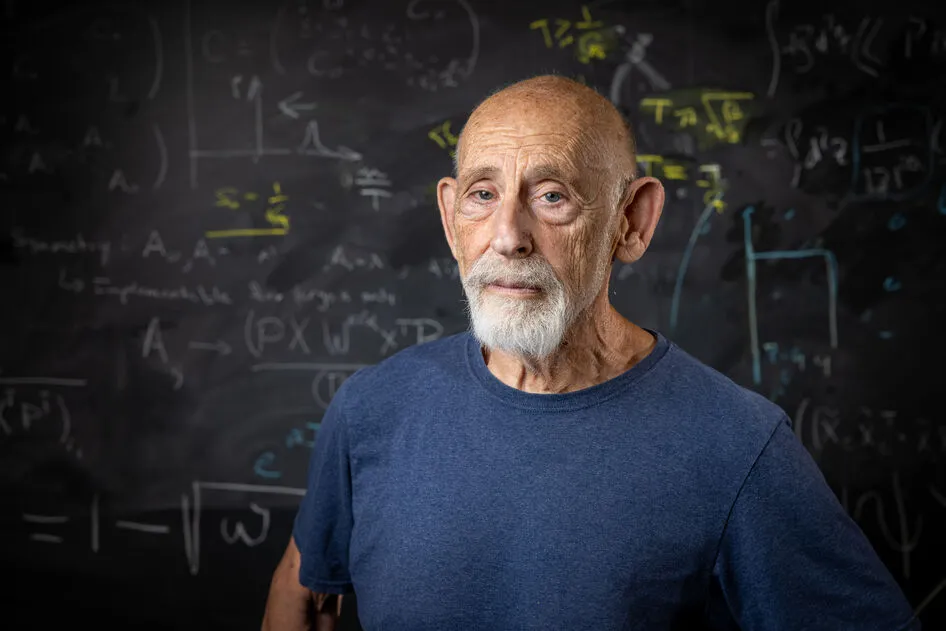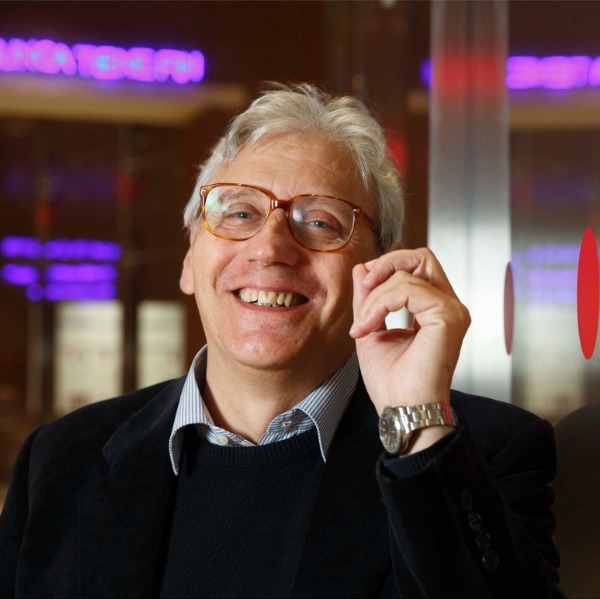Interview with Fulvio Ricci, Professor of Experimental Physics at Sapienza University of Rome and spokesperson for the international VIRGO collaboration at the time of the detection of the first gravitational signal
What are gravitational waves?
According to Albert Einstein’s general relativity, space and time are not immutable. They form a structure – spacetime – which depends on the distribution of matter and energy in the universe and which, in turn, tells matter and energy how to move and propagate. Based on this theory, if matter moves rapidly through space, the properties of space itself change, its measurement changes, and thus the distance between two points in that space changes. And when very large, compact masses move quickly, the change is not localised but spreads throughout the universe, like a stone falling into a pond produces ripples on its surface. A wave is generated, a wave of space, or rather a wave of changing spatial properties, which we call a gravitational wave.
From the theoretical prediction of gravitational waves, in 1916, to their discovery, a century passed. What made them so difficult to detect?
For the effect I have described to be detectable, the masses involved in the motion must be very compact, very large, and moving very rapidly. We are therefore talking about astrophysical processes with objects of stellar mass. Near these objects, the deformations of spacetime, the changes in its properties, are very significant. But the source is far from us, and the wave that propagates through space, crossing the entire universe, weakens progressively, leaving us with an extremely faint signal. It comes down to measuring something, with our detector on Earth, of the order of a ten-thousandth of nuclear dimensions, 10⁻¹⁸ or 10⁻¹⁹ metres of variation in the distance between two points: this is the characteristic magnitude of the wave, what we call strain, the deformation of spacetime.
What strategies did we adopt to detect this deformation?
Let me make a short historical digression. When Einstein presented his theory in 1915, and the following year the prediction of gravitational waves, he also made the first calculations to gauge the magnitude of their effect: he considered it so small as to be immeasurable. Indeed, in subsequent years he reinforced this view, mistakenly concluding that it was not a physical effect, i.e. that it did not involve energy transfer. Later he was proven wrong, but the problem of measurability remained open until the late 1950s, specifically 1957, the year of the “Conference on the Role of Gravitation in Physics” in Chapel Hill, North Carolina (United States). Among the participants was Richard Feynman, who performed a thought experiment: he imagined two rings sliding along a bar, with their mutual distance varying under the effect of a gravitational wave. The friction from their motion would generate heat, i.e. energy, making the effect measurable. This proposal sparked the interest of one of the attendees, John Weber, who was more of an engineer specialising in radio than a physicist (he actually contributed to the invention of the maser, the prototype of the laser), and who set about building a detector. He did not want to measure the heat released on the bar; Weber wanted to take the two rings – in reality he was thinking of two solid masses – and connect them with a spring, so that when the gravitational wave arrives, these two masses begin to compress and expand the spring, i.e. to introduce a vibration. He then realised that a large aluminium cylinder would be better suited: under the effect of a gravitational wave it would vibrate. He set out to measure these tiny vibrations – which he optimistically estimated at 10⁻¹⁶ or 10⁻¹⁷ metres (and not the 10⁻¹⁹ or 10⁻²⁰ metres they actually are) – and over the years claimed to have detected some signals, although parallel experiments produced contrasting results and ultimately nothing conclusive. However, further developments followed, thanks to which it was possible to increase the sensitivity of the instruments, and other players entered the scene: Edoardo Amaldi and Guido Pizzella, the fathers of gravitational wave research in Italy, interacted in particular with William Fairbank, a low-temperature physicist at Stanford, who suggested improving the sensitivity of the detectors by cooling their large cylinders to low temperatures. Each body, depending on its temperature, produces random vibrations, which are the manifestation of thermal noise. By lowering the temperature, it is possible to significantly reduce this noise, which is one of the main factors of interference in detectors, together with mechanical dissipation. Based on this insight, a triangle took shape, consisting of a low-temperature detector at Stanford, a low-temperature detector in Baton Rouge, Louisiana, and a third Italian detector. The Italian project was launched by Sapienza University of Rome, supported from 1980 by INFN, and the Italian detector, Explorer, was installed at CERN, in Switzerland. The three large bars of the triangle began operating and collecting data, and although they did not detect any significant event, they represented the first example of a gravitational antenna network. Then, for years, the low-temperature detector technology advanced: from Explorer, operating at 4–2 kelvin, to Nautilus, installed at the INFN National Laboratories of Frascati and operating at 100 millikelvin (0.1 kelvin), to Auriga, Nautilus’ twin detector installed at the INFN National Laboratories of Legnaro. This is the latest generation of cylinder detectors, the swan song.
What led to their being surpassed?
The first instruments had two major limitations: narrow detection bandwidth and small size. Being resonant instruments, they were sensitive only to vibrations around their resonance frequency (about 1 kilohertz). In practice, they functioned like a radio tuned to a station: they could pick up signals in that narrow frequency range, losing everything else. Moreover, with bars only a metre long, they could probe only a very limited spatial region. To understand the properties of spacetime, we needed to expand our observation window, and that is exactly what happened with the next step.
What was the next step?
Resonant bars were replaced by interferometers. Also designed to investigate the properties of spacetime, interferometers no longer rely on a mechanical response (i.e. linked to the bar and its ability to vibrate when a gravitational wave passes), but on almost-free-falling objects moving with spacetime. According to Einstein’s theory of relativity, a passing gravitational wave stretches spacetime along one direction while compressing it along the perpendicular one. By placing almost-free-falling objects – suspended mirrors – at the ends of two perpendicular arms, it is possible to measure this tiny variation in distance by exploiting the propagation time of light. Today, even on construction sites, distances are no longer measured with a metre stick, but by bouncing a light beam between two walls. Similarly, in interferometers, two laser beams, or a laser beam split into two parts, are bounced back and forth between mirrors in order to measure, in the same time interval, how the distance changes along one direction and along the other. This difference is calculated with extreme precision by recombining the two signals interferometrically, i.e. by superimposing the electromagnetic fields of light propagating along the north-south direction and along the west-east direction.
What advantages do interferometers offer over resonant bars?
First of all, there are structural advantages: by suspending the mirrors to recreate the condition of almost-free-fall, it is possible to drastically reduce vibrations linked to seismic motion; and by using much longer apparatuses, with arms of the order of kilometres rather than metres, the properties of spacetime can be tested over greater distances. But above all, the extraordinary advantage of this type of detector compared with the previous ones is their ability to detect gravitational waves regardless of their frequency. In principle, any wave becomes detectable; practical problems then arise, both at low and at high frequencies. At low frequencies, it is not possible to take measurements below 2, 3, 4 hertz, due to interference from seismic noise, attenuated by the suspensions but not eliminated. At high frequencies the limit is imposed by the travel time of light bouncing between the mirrors, which must be shorter than the characteristic oscillation time of the gravitational wave if it is to be detected (a condition not guaranteed when probing a very large portion of space). The interferometers built up to now are fairly efficient in the range from a few hertz up to 10 kilohertz and are much richer in information compared with the previous detectors. Their history begins in the 1980s, but they only came into operation in the early 2000s: LIGO, with the twin observatories Livingston and Hanford in the United States, and Virgo, in Italy, built on the initiative of Adalberto Giazotto (INFN) and Alain Brillet (CNRS); three infrastructures designed to work together, like the aforementioned antennas. Interferometers, in fact, cannot be compared to optical telescopes pointing towards the sky, but are sensitive to signals coming from almost all directions. Identifying and locating the source of these signals requires an accurate triangulation system, able to exploit the differences in reception times among the various instruments of the network (we are on the scale of milliseconds) and the differences in signal amplitude, linked to the relative orientation of each ground-based detector with respect to the direction of propagation. LIGO and Virgo reached an agreement to work as a network as early as 2007, sharing information on hardware and above all committing themselves to conduct data analysis in coincidence, and their progress in terms of sensitivity and investment proceeded in parallel, up to the moment of the discovery of gravitational waves.
Let’s talk about the discovery: what happened on 14 September 2015?
As we were saying, these detectors began collecting data in the early 2000s and, once their efficiency had been established, proposals began to arrive to introduce significant improvements both to LIGO and to Virgo. LIGO began its upgrade two years before Virgo, in 2009, and all three instruments underwent major restructuring work – six years of work each – before arriving at their improved versions: Advanced LIGO and Advanced Virgo. In 2015, LIGO was ready for its first data run. It was still in its engineering phase, its behaviour was not yet fully under control, but the two observatories were relatively stable and the tests were becoming increasingly accurate. The leadership of LIGO and Virgo – Gabriela Gonzalez, spokesperson of the LIGO Scientific Collaboration, David Reitze, director of LIGO, and myself, heading the Virgo scientific collaboration – set up an accurate hierarchy of protocols to follow in the event of interesting results, and the analysis groups, organised in regular shifts, checked all the data and analysed them online. On 14 September 2015, Marco Drago, a young researcher at the Max Planck Institute in Hanover, northern Germany, was on shift analysing data with an algorithm, coherent WaveBurst, built to look for excess power, transient signals without a particular structure. And Drago saw a rather intense signal. Other analysis groups immediately intervened, looking at the data with different algorithms, and one wondered why the algorithm for chirp searches (signals with a sinusoidal structure that increases in frequency over time, becoming denser and stronger, and then suddenly stops) was unable to see anything. We were all convinced that the signal had been generated in the coalescence process of two neutron stars, relatively light astrophysical objects with masses of about one and a half times the mass of the Sun. But there were no signals generated by structures with masses of this order, and none were seen until the analysis group broadened the search field to larger masses. Out then came, even from the chirp algorithm, a very clear gravitational signal. We then began to work on the parameters and realised that the masses of the objects that had orbited each other until they met and merged were masses compatible only with objects identifiable as black holes. The issue became even more imposing: this was not only the first detection of a gravitational signal, but also the first detection of signals from black holes, and indeed of a binary system of black holes. It was extraordinary, but we were haunted by the terrible doubt that it might be a false signal, a disturbance, or a blind injection, a simulation test during which a restricted group “injects” into the detectors a signal compatible with gravitational ones, without the rest of the collaboration being aware of it. At the time we were about a thousand people from four continents, so we began a long process of verifying the quality of the signal and its parameters with this doubt hanging over us. Then, once the origin of the signal was established, with the utmost discretion we wrote the article and submitted it to the journal Physical Review Letters. I myself in particular kept my foot on the brake. In the hundred years that had passed since Albert Einstein’s prediction, several fake announcements had occurred, announcements that later turned out to be unfounded. It was crucial that we ensured the maximum scientific credibility. And it was an important, complicated operation, which only concluded on 11 February 2016, when we made the public announcement in Washington at the headquarters of the National Science Foundation, and in Cascina (PI) at the headquarters of the European Gravitational Observatory, where Virgo is located.
What did this announcement mean?
Scientifically, in my opinion, it is one of the greatest achievements in physics in the past seventy years. It is a huge leap forward, and we were aware of that from the very beginning. Personally, I announced it with great emphasis using a rather unoriginal phrase, “A new window has opened onto the universe”, a phrase in which, however, I believed and still believe deeply. That moment inaugurated a new way of studying the invisible. The universe, until then explored through electromagnetic radiation and neutrinos, provided us with information through yet another messenger, with which we can even study the physics of black holes, which is something extraordinary. Not by chance, the media response that followed the announcement was enormous, in keeping with the magnitude of the discovery; a discovery that is the result of a thousand people who believed in it, great figures who built their careers on it – in Italy Adalberto Giazotto, and before him Edoardo Amaldi and Guido Pizzella, and many others. It was a remarkable, international collective effort, and I am proud to have been among the protagonists, and proud of INFN, which since 1980 had believed in this line of research, making a farsighted and wise choice.
BIO
Fulvio Ricci is Emeritus Professor of Experimental Physics at Sapienza University of Rome. He began studying the problem of the direct detection of gravitational waves in the 1970s under the supervision of Professors Edoardo Amaldi and Guido Pizzella. Having become an expert in experimental gravitation and gravitational wave detection systems, and the author of numerous publications in international journals, he was for several years first national coordinator for INFN of the VIRGO experiment and then spokesperson of the international collaboration from 2014 to 2017.






